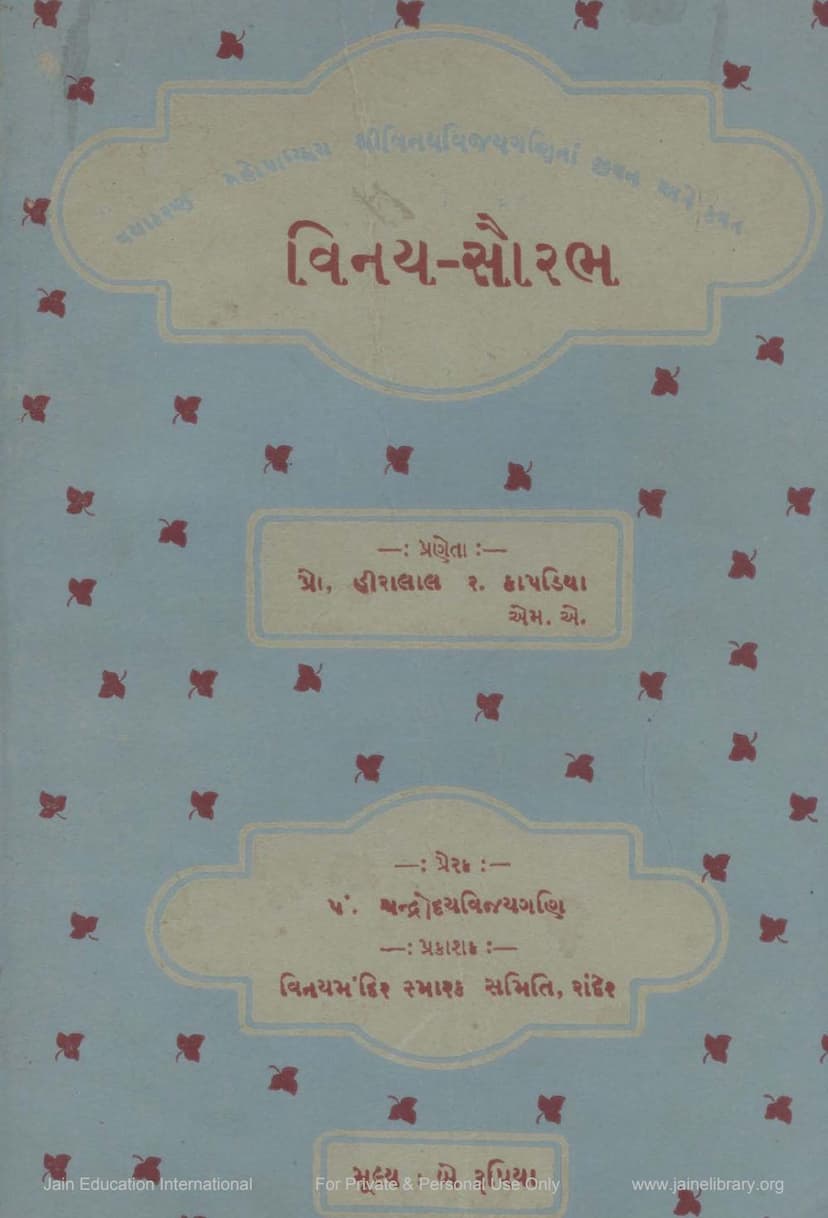Vinay Saurabh
Added to library: September 2, 2025

Summary
This is a comprehensive summary of the Jain text "Vinay Saurabh" by Hiralal R Kapadia, based on the provided catalog link and page excerpts:
Book Title: Vinay Saurabh (વિનય-સૌરભ) Author: Hiralal R Kapadia (હીરાલાલ રસિકદાસ કાપડિયા), M.A. Publisher: Vinaymandir Smarak Samiti, Rander (વિનયમંદિર સ્મારક સમિતિ, રાંદેર) Inspiration/Patronage: Pt. Shrichandradayavijaygani (પં. શ્રીચન્દ્રયવિજયગણિ) Publication Year: Vikram Samvat 1918 (V.S. 1918) / 1962 C.E. Edition: First Edition Print Run: 750 copies
Subject Matter: "Vinay Saurabh" is a biographical and literary study dedicated to Mahopadhyaya Vaiyakarana Shri Vinayavijay Gani (મહોપાધ્યાય વૈયાકરણ શ્રીવિનયવિજયગણિ), a prominent Jain scholar and poet. The book delves into his life, teachings, and extensive literary works.
Key Aspects and Content:
-
Focus on Vinayavijay Gani: The primary purpose of the book is to illuminate the life and literary contributions of Vinayavijay Gani, who was a significant figure in Jain literature and culture. The title itself, "Vinay Saurabh" (Fragrance of Vinay), signifies this focus.
-
Structure of the Book: The book is divided into two main parts:
- Sanskar Vatika (સંસ્કાર-વાટિકા): Outlines of External Life: This section details the external aspects of Vinayavijay Gani's life, including his family background, education, gurus, entry into monastic life, scholarly pursuits, travels, and eventual demise.
- Kavan Kunj (કવન-કુંજ): Garden of Literary Works: This section is dedicated to his literary output. It is further divided into three sub-sections based on the chronology of his works:
- Purvavarti Kavan-Kunj (પૂર્વવર્તી કવન-કુંજ): Preceding Literary Works (V.S. 1689 – V.S. 1708)
- Uttaravarti Kavan-Kunj (ઉત્તરવર્તી કવન-કુંજ): Succeeding Literary Works (V.S. 1710 – V.S. 1738)
- Madhyavarti Kavan-Kunj (મધ્યવર્તી કવન-કુંજ): Intermediate Literary Works (Works where the composition period is uncertain but roughly fall within his lifetime).
-
Detailed Literary Analysis: The book meticulously catalogues and analyzes Vinayavijay Gani's works. It provides details on:
- Number of Works: The text highlights that 40 of his works are presented in this book, adding to the 25 known previously, and mentioning 35 still unpublished works.
- Languages: His works span across Sanskrit, Prakrit (Paiy), Gujarati, and Hindi.
- Genres: His literary creations encompass poetry (kavya), commentaries (vrutti), devotional hymns (stavana), philosophical treatises, grammatical works, historical accounts, and narrative poems (ras).
- Specific Works Discussed: The book elaborates on numerous specific works like 'Surati Chaitya Paripati', 'Kalpa-subodhika', 'Anandalekh', 'Lokaprakash' (described as a "Jain Encyclopedia"), 'Shrīpāl Rājāne Rās', and many others. The analysis includes information about their themes, structure, language, poetic devices, and sometimes, their historical context.
-
Biographical Information: The "Sanskar Vatika" section covers significant aspects of his life:
- Family: Mentions Tejpal and Rajshri as his likely parents.
- Education: Details his learning under gurus like Kirtivijay and Gyanavijay.
- Monastic Life: Discusses his initiation and the period he spent under different spiritual lineages, noting his shift from the 'Anachuri' sect to the 'Devasuri' sect around V.S. 1705.
- Scholastic Achievements: Highlights his role as a grammarian ('Vaiyakarana'), a scholar of Jain philosophy, and a prolific writer. He is noted for his contribution to Kriyoddhar (restoration of practices).
- Travels: Mentions his journeys primarily within Gujarat, but also to Marwar and Malwa.
- Death: Records his demise in Rander in V.S. 1730.
- Legacy: Discusses the "Vinay Mandir" (a memorial) established in Rander in his honor.
-
Methodology: Kapadia employs a scholarly approach, referencing other Jain texts, manuscripts, and historical records to reconstruct Vinayavijay Gani's life and works. He acknowledges the limitations due to the scarcity of direct biographical accounts from his time.
-
Publisher's Note (Prakashakiya): The introductory notes from the Vinaymandir Smarak Samiti highlight the inspiration for the book and the memorial project. It details the efforts initiated by Acharya Shri Vijaykasur Surishwarji and Panas Shri Chandrodayavijay Gani to honor Vinayavijay Gani, leading to the establishment of the "Vinay Mandir Smarak Samiti" and the "Vinay Mandir" memorial structure. It also mentions the significant financial contributions and community involvement in this project.
-
Author's Preface (Paripak): Kapadia's preface explains his motivation for writing the book, emphasizing the vastness and diversity of Jain literature and his own engagement with its history. He outlines the structure of "Vinay Saurabh," detailing the division into "Sanskar Vatika" and "Kavan Kunj," and the sub-sections within "Kavan Kunj." He also discusses the classification of works by language, theme, and form.
Significance:
- Preservation of Knowledge: The book serves as a crucial resource for understanding the life and extensive literary legacy of Mahopadhyaya Vinayavijay Gani, contributing significantly to Jain hagiography and literary history.
- Scholarly Contribution: It represents a dedicated and detailed scholarly effort to compile and analyze the works of a major Jain author, providing valuable insights into Jain philosophy, grammar, literature, and socio-historical contexts of the 17th and 18th centuries.
- Memorialization: The publication is directly linked to the creation of a memorial for Vinayavijay Gani, reflecting the community's respect and desire to honor his contributions.
In essence, "Vinay Saurabh" is a scholarly tribute that meticulously documents and celebrates the multifaceted life and prolific literary career of a remarkable Jain scholar, Mahopadhyaya Vinayavijay Gani.